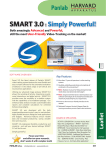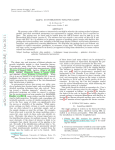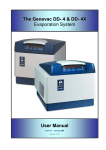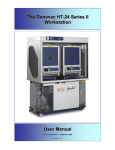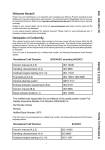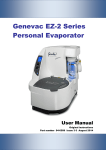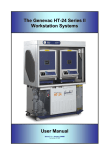Download Study Guide Introduction
Transcript
TECHNICIANS CERTIFICATION TEST STUDY GUIDE KOHLER ENGINES STUDY GUIDE TABLE OF CONTENTS Introduction About This Study Guide ........................................... 4 About Certification ................................................... 5 A Word About Genuine Kohler Parts ....................... 6 Sample Questions Reference Guide ...................................................... 7 Question Overview ................................................... 8-9 Questions ................................................................. 9-16 Answer Sheet ..................................................................... 17 Kohler Engines Study Guide Introduction 3 ABOUT THIS STUDY GUIDE Hello. My name is Professor du Lotz. I will be your navigator through this study guide, providing you with sample questions, important study hints and additional reference resources. The guide has been developed to give you a clear understanding of the context and style of Kohler’s Technician Certification Test. It is designed to be educational, meaningful, and even provide a smile or two. Most of the information in this guide relates specifically to Kohler products and factory-suggested procedures. The guide does not cover basic fourstroke fundamentals in detail, but there are some in the first section to get you in the right frame of mind. It is assumed that candidates already have a thorough understanding of topics covered in EETC Certification Test. This study guide is in a similar format to the actual test and has sample questions that may appear on the actual test. The actual test will be broken down into the following sections: Engine Theory Electrical Theory & Troubleshooting Fuel Systems Engine Measurements Engine Analysis & Warranty Service/Maintenance/Tool Usage Although this guide does not cover all of these topics, it will prepare you for the types of questions that may be drawn from each of these areas for the actual test. To adequately understand these subjects, I highly recommend you review the following Kohler Co. booklets and manuals, which are included in this study guide. Owners Manual Command 18-26 TP-2474-H Service Manual Command 18-745 TP-2428-B Measurement Guide TP-2159-B Principles of Engine Operation TP-2209 Specs & Torques Book TP-2469 Engine Electrical Systems TP-2210-A Carburetor Reference Book TP-2377-D Warranty Policy & Procedure Book TP-2303-F Failure Analysis Book TP-2298-B Guide to Engine Rebuilding TP-2150-A Parts Identification is not listed or part of the actual exam, but it is beneficial that you have knowledge of parts look-up procedures. It will help with nomenclature and identifying certain items, which may be Kohler specific. 4 Introduction Kohler Engines Study Guide The certification test contains one hundred and eighty questions, and you will have two and half hours to complete it. To help you prepare for the areas of the test that relate to Kohler products and procedures, this study sheet contains sample questions similar to those you can expect to encounter on the exam. An answer sheet is included at the back of the study guide (No peeking!). The guide also includes Kohler reference materials which you can use as study materials now, and on the job later. If you need to familiarize yourself with additional reference materials that are not included in this guide, those materials will be listed in the front of each section. NOTE: The design and intent of the certification test is not to see how much you have memorized, but more importantly, that you can find the information needed. Therefore this test allows the use of service manuals and/or the study guide. Our goal is to help you successfully complete the exam. If, after reviewing the guide, you have any questions about the test, contact the Kohler Technical Publications Department at (920) 453-5808 or (920) 457-4441 ext. 77172. Good Luck! ABOUT CERTIFICATION Kohler Expert Dealers are required to have one (1) certified technician (two would be preferred) on staff. To gain certification, candidates must pass the Kohler Technicians Certification test and be renewed every three years, in conjunction with attending annual Kohler Technician Update schools. Benefits of Kohler Certification are both personal and professional. Certification helps ensure that technicians are able to provide the highest quality service and assistance to owners of Kohler-powered equipment. Certified Technicians are authorized to approve short block, miniblock, and engine replacements under warranty, at Expert Dealer locations. Equally important, technicians gain prestige and credibility in the eyes of customers who appreciate doing business with factory-certified professionals. In particular, individuals who rely on Kohler-powered equipment to make their living or to keep their businesses operating are more likely to seek out Expert Dealers because of the higher caliber of service they can expect to receive from Certified Technicians. Similarly, equipment sales are often enhanced because customers are assured that Kohler Expert Dealers are better able to quickly take care of service problems both during and after the warranty period. Certified Technicians are valuable Expert Dealer resources who provide: • • • Courteous, knowledgeable responses to customer questions. Fast and accurate diagnosis of customer problems. Quick turnaround of customer equipment when it requires service. Those who wear Kohler’s official Certified Technician emblem on their uniforms are distinguished as having exceptional competence and high standards for meeting customer needs and expectations. Kohler Engines Study Guide Introduction 5 A WORD ABOUT GENUINE KOHLER PARTS Reliability and high performance are major factors in attracting customers to Kohler Engines and convincing customers to insist on Kohler when they buy additional equipment or replacement engines. Kohler state-of-the-art engines are manufactured to precise specifications and exacting tolerances. They are subjected to countless balance, vibration, quality and parts compatibility tests to ensure exact component fit and reliable operation. Randomly selected imitation replacement parts show extreme variations in quality and fit. The compromise made in the production of these imitations affect performance and engine life. The use of imitation parts can damage a customer’s equipment and your reputation. Kohler genuine parts have the same consistent quality that is built into every Kohler Engine. Technicians can educate customers about the time and resources that are spent in research, design and production of every part that goes into a Kohler engine. Customers should know that significant design and quality differences can exist between genuine parts and imitation replacements. Over time, the performance and reliability of a Kohler engine is best protected by using parts manufactured to original equipment specifications. 6 Introduction Kohler Engines Study Guide SAMPLE QUESTIONS REFERENCE GUIDE Subjects Engine Theory and Fundamentals ........................... 9 Electrical Theory & Troubleshooting ........................ 9 Fuel Systems ........................................................... 11 Engine Measurements ............................................. 12 Engine Analysis & Warranty .................................... 12 Service/Maintenance/Tool Usage ............................. 14 Application & Crankshaft Guides ............................. 15 Kohler Engines Study Guide Sample Questions 7 OVERVIEW ENGINE THEORY AND FUNDAMENTALS The questions in this section come from but are not limited to “Principles of Engine Operation” booklet TP-2209 and your general knowledge. If this does not get you thinking in the right way, you are in for a hard test! ELECTRICAL THEORY & TROUBLESHOOTING This section comes from, but is not limited to, “Engine Electrical Systems” TP-2210-A. We have also added test procedures from the various service manuals and service bulletins that for the most part, are Kohler specific. Additional books to study here would be any of our service manuals (i.e. TP-2428-B), bulletins (ESB-253), and updates, which include magneto, solid state, CD ignition, and SMART-SPARK™. You should also be familiar with the service and test procedures for Kohler Co. charging and starting systems. We have combined theory and test procedures together in this section. Hint: Pay special attention to proper engine disassembly and assembly procedures shown in the service manuals. FUEL SYSTEMS This section of the test is made up from information supplied in “Principles of Operation,” service manuals, and service manual supplements which not only include basic Kohler carburetion but will also include EFI (Electronic Fuel Injection) and LP Fuel Systems. ENGINE MEASUREMENTS This section is made up from information supplied in our “Measurement Guide” (TP-2159-B), our ‘‘Specs & Torques” (TP-2469), and our “Guide to Engine Rebuilding” (TP-2150-A). ENGINE ANALYSIS & WARRANTY This section is made up from information supplied in our “Failure Analysis Book” (TP-2298-B) and “Policy & Procedure Book” (TP-2303-F). Your common engine knowledge and appropriate relationships with needed requirements should enable you to handle all questions. SERVICE/MAINTENANCE/TOOL USAGE This section is made up from the following: “Owners Manual” (TP-2474-H), “Command Service Manual” (TP-2428-B), “Specs & Torques” (TP-2469), and “Measurement Guide” (TP-2159-B). 8 Sample Questions Kohler Engines Study Guide APPLICATION & CRANKSHAFT GUIDES This section is made up from information supplied in the “Principles of Engine Operation” (TP-2209) as well as from charts supplied within the test book itself. SAMPLE QUESTIONS SECTION 1: ENGINE THEORY AND FUNDAMENTALS 1. The volume inside a cylinder between BDC and TDC is called: A. bore. B. stroke. C. compression ratio. D. displacement. 2. Typical compression ratios for gasoline engines range from: A. 5.5:1 to 10.5:1 B. 10.5:1 to 15.5:1 C. 15:1 to 20:1 D. 20:1 to 25:1 3. Viscosity of the crankcase oil should be based on: A. the air temperature at the time of operation. B. how much the engine will be used. C. the load that will be placed on the engine. D. engine horsepower. 4. When disassembling an engine, the parts must be cleaned thoroughly because: A. the customer will appreciate it. B. new paint won’t stick to the dirt and grease. C. they can then be accurately inspected and gauged. D. it reflects pride in your work. SECTION 2: ELECTRICAL THEORY & TROUBLESHOOTING 5. An ignition coil which has failed after 500 hours of operation has produced as many as _____ ignition sparks over its life. A. 50,000 B. 500,000 C. 5,000,000 D. 50,000,000 Kohler Engines Study Guide Sample Questions 9 6. Higher spark energy at low RPM’s on Magnum engines is made possible in part due to: A. the position of the module inside the flywheel which increases the radius. B. a 1:46 primary/secondary ratio. C. a larger permanent magnet. D. more laminations in the iron core. 7. The spark plug in a magneto ignition will fire: A. when the breaker points open. B. when the breaker points close. C. at the moment the primary windings are ‘‘cut’’. D. at the moment the primary circuit closes. 8. The Magnum ignition module has a three-leg laminated iron core and: A. a coil with primary and secondary windings. B. a small ‘‘triggering coil’’. C. a coil with primary and secondary windings and a small ‘‘triggering’’ coil. D. a coil with primary and secondary windings, a small ‘‘triggering’’ coil, and eliminates the need for a flywheel magnet. 9. When measuring the secondary resistance of an ignition module with an ohmmeter, you find that the resistance is infinity ohms. What do you do next? A. Move on. The module is OK. B. Replace the module. C. Replace the ‘‘triggering’’ coil. D. Check for problems which could apply 12 volts to the kill terminal. 10. To test a 15/25 amp charging system, the voltmeter should be read: A. with the engine off. B. with the engine warmed up. C. with the engine running at 3600 RPM. D. with the engine running at 1000 RPM. 11. The electrical relay in an EFI system supplies power to the: A. fuel pump circuit. B. ignition coils. C. fuel injectors. D. all of the above. 10 Sample Questions Kohler Engines Study Guide 12. You have a starter on a CH22 that will not energize. Choose the three most likely faults from the following list: 1. battery 2. transmission 3. wiring 4. brushes 5. engine 6. circuit breaker 7. solenoid A. 5, 6, 7 B. 1, 2, 3 C. 3, 4, 5 D. 1, 3, 7 13. The SAM needs a minimum of _______volts for proper operation. A. 7.25 B. 6.75 C. 9.00 D. none of the above SECTION 3: FUEL SYSTEMS 14. Maximum power in a gasoline engine is usually reached with an air-fuel ratio of about: A. 7:1 B. 13:1 C. 19:1 D. 25:1 15. The dual fuel system: A. does not use an ECU. B. closely monitors the carbon monoxide levels in the exhaust. C. uses an oxygen sensor. D. none of the above. 16. The fuel in a CH18-25 LPG system is released from the supply tank in what form? A. Liquid B. Gas C. Combination of gas and liquid D. Varies depending on operating conditions Kohler Engines Study Guide Sample Questions 11 17. A clogged fuel injector problem on an EFI system may exhibit what symptom? A. Rough idle. B. Hesitation during acceleration. C. Fault codes related to fuel delivery. D. All of the above. 18 If a fuel injector in an EFI system is not operating: A. apply voltage to the fuel injector(s). B. connect a test light across the terminals in one injector connector and crank the engine over, watch for the test light to flash. C. ground the injector(s) to check if injector(s) will open/turn on. D. none of the above. SECTION 4: ENGINE MEASUREMENTS 19. To measure the diameter of a cylinder bore you need: A. an outside micrometer. B. an outside micrometer and a telescoping gauge. C. a feeler gauge. D. a wire gauge. 20. Maximum out-of-flatness for a cylinder head is: A. 0.001 B. 0.002 C. 0.003 D. 0.004 21. Cylinder head flatness is measured with: A. a wire gauge. B. a feeler gauge. C. an inside micrometer. D. a telescoping gauge. SECTION 5: ENGINE ANALYSIS 22. A customer brings in their lawn tractor equipped with a CH18 engine and complains of oil consumption, smoking, and an engine knock. What would be your first step in diagnosing the problem? A. Recommend a rebuild. B. Remove the cylinder heads for inspection. C. Perform a preliminary examination. D. Start a tear down analysis. 12 Sample Questions Kohler Engines Study Guide 23. An L-head engine has heavy ring wear with little or no bore wear. What conditions might have caused this? A. Lack of oil. B. Contaminants in the cylinder. C. High operating temperatures. D. Fuel dilution in crankcase oil. 24. A piston with black, scorched deposits on the skirt could indicate: A. insufficient running clearances. B. the piston was defective. C. loss of oil pressure. D. high combustion temperatures and restricted cooling. 25. Choose the response that contains only the item or items from the list below that are covered under Kohler’s warranty. 1. Normal wear. 2. Routine tune-up or adjustment. 3. Damage due to improper handling or accident. 4. Damage caused by a defective part. 5. Damage due to improper or insufficient lubrication. 6. Damage caused by faulty workmanship in manufacture. A. 5 B. 2, 5 C. 3, 6 D. 4, 6 26. A customer is willing to wait for a warranty decision prior to having the services performed. You should: A. complete a Warranty Claim and Engine Inspection Data Record and have your Central Distributor representative review the failed parts and forms. B. complete a Warranty Claim form, sign box 12 or 17, perform the repair, and send the form to Kohler Co. C. inform the customer that, as a matter of procedure, the repair has to be made first in order to settle any areas of dispute. D. contact the Central Distributor to set up an ‘‘on site’’ inspection of the damaged parts. Kohler Engines Study Guide Sample Questions 13 SECTION 6: SERVICE/MAINTENANCE/TOOL USAGE 27. On a CH25, the oil filter should be changed: A. with every oil change. B. when it starts to leak. C. when the Oil Sentry™ light comes on. D. every 200 hours. 28. You inspect a CV18 for a breather problem. The crankcase vacuum reading shows pressure. Where would you find the breather reed(s)? A. In between #1 and #2 cylinder, under the breather cover. B. On the #1 and #2 cylinder between the hydraulic lifter bores. C. In the breather canister, located on the #1 valve cover. D. In the breather canister, located on the #2 valve cover. 29. Testing an Oil Sentry™ pressure switch requires a pressure regulator, pressure gauge, continuity tester and: A. an ammeter. B. a vacuum gauge. C. an oil sump thermocouple. D. compressed air. 30. While performing a leakdown test, the gauge reads in the ‘‘low’’ zone. How do you interpret this? A. A defective exhaust valve. B. Piston rings and cylinder are in good condition. C. Some wear on the cylinder walls but the engine is still useable. D. Engine should be reconditioned or replaced. 31. You are testing for spark using a Kohler ignition tester on a CH20 and find neither side firing. What is your next step? A. Recheck the position of the ignition switch and check for a shorted kill lead. B. Check the battery voltage to the SAM. C. Check the red, green, and white lead from the SAM. D. Connect the ignition tester to the yellow lead at one of the ignition modules, crank the engine and observe the LED. 14 Sample Questions Kohler Engines Study Guide SECTION 7: APPLICATION & CRANKSHAFT GUIDES EFFECT OF ALTITUDE ON HORSEPOWER 100% 96.5 3.5% Drop (for every 1000' above sea level) NOTE: Engines operating at altitudes 6000' and higher may need a special high altitude main fuel jet in carburetor. 7.0 Drop 93.0 10.5 Drop 89.5 14.0 Drop 86.0 17.5 Drop 82.5 21.0 Drop 79.0 24.5 Drop 75.5 72.0 Sea Level 1000' 2000' 3000' 4000' 5000' 6000' 7000' 28.0 Drop 8000' Chart: Altitude Effect on HP. Figure 1. 32. In Figure 1, what percentage of horsepower is available to an engine operating at 4000 ft. above sea level? A. 82.5% B. 86% C. 89.5% D. 93% Kohler Engines Study Guide Sample Questions 15 TRANSMISSION EFFICIENCIES CHART Transmission Direct Coupled V-belt Roller Chains Spur Gears Gear Reductions Pumps Efficiency (Typical) 100% 96-98% 95-97% 96% (Contact Manufacturer) 50-80% Figure 2. 33. Using Figure 2 as a guide, what percentage of power is lost using a belt and pulley type drive system? A. None B. 2-4% C. 3-5% D. 20-50% 34. A customer has designed a new machine and needs an engine. They estimate the power requirement will be 4 HP at 3600 RPM. The transmission will be a friction drive system (spur gears). It will be operated at an altitude of 2000 feet. Use Figures 1 and 2 to determine what percentage of horsepower loss should be figured in when choosing the right engine for this application? A. 3% B. 7% C. 11% D. 15% 16 Sample Questions Kohler Engines Study Guide ANSWER SHEET 1. 2. 3. 4. 5. 6. 7. 8. 9. 10. 11. 12. D A A C D B A C B C D D Kohler Engines Study Guide 13. 14. 15. 16. 17. 18. 19. 20. 21. 22. 23. 24. A B D B D B B C B C C D 25. 26. 27. 28. 29. 30. 31. 32. 33. 34. D A D B D B A B B C Answer Sheet 17 LITHO IN U.S.A. Revised 9/04

















